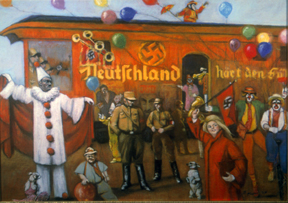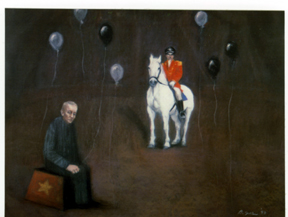Barbara Green at Lotus Fine Art
By
RAYMOND J. STEINER
ART TIMES October 2007
 The Circus Begins 1993 pastel |
DURING
HITLER’S GERMANY, a joke began circulating among Berlin’s Jewish population
and it went something like this: One day, a brown-shirted storm trooper
grabbed the handlebars of a Jewish bicyclist, roughly halting the man
in his forward motion. “Who started the war, Jew?” the Nazi demanded loudly.
The Jew, head bowed down, said deferentially, “The Jews, sir.” And then,
slightly raising his eyes, he added, “And the bicycle riders…sir.” Taken
aback, the brown-shirt puzzedly asked, “Why bicycle riders?” The
Jew, now looking directly into the Nazi’s eyes, shrugged his shoulders
and, head tilted to one side, answered, “Why the Jews?”
Humor. Webster’s New Universal Unabridged
Dictionary, among other entries, defines “humor” as “the ability to
perceive, appreciate, or express what is funny, amusing, or ludicrous…”
And, as does Webster albeit more briefly, my Compact Edition of the
Oxford English Dictionary adds: “Distinguished from wit as
being less purely intellectual, and as having a sympathetic quality in
that it often becomes allied to pathos.” Jokes in the face of suffering.
And “ludicrous”? What can be more preposterous than characterizing the
holocaust as the opening of a Circus? Who would think of such a thing?
 The Dialogue 1993 pastel |
Although Berliners of all stripes were famous for their
“gallows” humor — when faced with their own pathos, the following
jokes were being passed around amongst Germans as they huddled in bomb
shelters around the city during the Allied bombing in 1945: “Be practical
this Christmas — buy your loved ones a coffin” and “What’s the difference
between an optimist and a pessimist? The optimist is frantically learning
English while the pessimist is resignedly studying Russian.” [1] — Jewish humor as a defense against despair is
probably as old as their first displacement over 2,000 years ago. More
than likely, it is the Jews who can be credited with “inventing” gallows
humor — for who better than a Jew knows that, in almost all cases,
it is the only “human” answer to the ludicrous, to the unreasoning senselessness
of unwarranted cruelty, to the utter darkness of pathos at its nadir.
It is in this tradition of seeing the “humorous”
side of something as terrifying as a holocaust, that Barbara Green presents
“Der Zirkus Beginnt”.* How else than by depicting Adolf Hitler as a clown
foolishly gesticulating like a hanswurst before pictures of his
“soldaten” painted on the side of a gaily-painted circus wagon or Heinrich
Himmler as a stern-faced ringmaster in black cap, jodhpurs, and red uniform,
can we get our minds around the enormity of this outrageous period of
our history? After all, this was a “circus” in the grand Roman tradition
of bloodletting as public entertainment, was it not? Why ought not the
world applaud the spectacle of these forlorn and shoeless performers garbed
in striped pajamas and dingy colors so dramatically depicted by Barbara
Green — bareback riders on merry-go-rounds that go nowhere, tightrope
walkers tethered to tent poles, sorrowful tumblers, angst-ridden figures
sitting upon stools waiting for the lion (symbol of David?)-tamers commands
— all responding to the raised whip of the handsomely clad masters
while being surrounded in a festive atmosphere of noisy parades, vigilant
brown-shirts with red, white and black swastika-decorated armbands, multi-colored
balloons rising aloft, and handpuppenspiel? Did this debasement
of the human soul not validate the ancient dictum of “might makes right”
— a law that has been in force since the invention of the very first
cudgel fashioned from an oaken tree limb?
 The Pink Triangle 1994 pastel |
Haunting
images leap from the canvases and drawings of Barbara Green’s Zirkus
— terrified family groups in open fields identified as a “sideshow”,
indistinct faces looming out of darkened backgrounds, swastikas decorating
walls and wagons, monkeys with umbrellas, a child clad in white in a sea
of black, huddled mothers and offspring herded into tents under the watchful
eye of Ringmaster Himmler and his gentlemanly admonition of “Women and
Children First”, graffitied walls futilely asking viewers to “seek justice”,
a pretty blonde waving a Nazi flag, regal eagles (German? American?) emblazoned
on waving “fahnen” or silhouetted with outspread wings enveloping a hodge-podge
of human bones under the paternal heading of “Fatherland”. Though nowhere
as ghastly as those photographs taken after the liberation of Hitler’s
concentration camps, Green’s color-laden images of one of the darkest
of “Grim” fairy tales — in all their thinly-disguised horror, their
inhumanity in the guise of entertainment, speak just as trenchantly, just
as clearly, as do the black and white snapshots of dead, emaciated, and
mangled heaps of bodies that were brought to world attention after the
war.
Still, Green allows for some hints of lightness
to alleviate the Stygian darkness of a world gone mad, some hope for a
different future, a world where all are on equal footings. One glimpses
a yellow Monarch butterfly, a dancing dog, a white rose in the hand of
Sophie Scholl, an opening at the end of a wall, a small window letting
a modicum of light into a concrete cell — insignificant perhaps
in such a hellish context, yet tentative indicators that hope springs
eternal. Whether that world
is still to come — whether it ever will come, is left for the viewer to ponder. This is not an exhibition
designed to delight the senses, but it is one that will linger in the
mind for some time. If there is what might be called a “bright” side,
it is the fact that Barbara Green, teacher as well as artist, is a master
story-teller, her skill with brush, pastel or charcoal stick as fluent
— nay, more fluent — than the most facile of wordsmiths attempting
to describe the atrocities of Nazism.
Some twenty-five works — oils, pastels,
charcoal drawings — make up this exhibit, more than enough to adequately
tell the macabre story of the “Final Solution.” Green is a rare talent
— an accomplished painter that goes far beyond skillful technique.
She is an artist with sensitivity, compassion, vision, and a true sense
of what all great art is about — the enlightenment of mankind.
Kudos
to the co-owners of Lotus Fine Art, Director Jamie and her husband Doug
Barthel, for both mounting this exhibition and for their efforts on the
behalf of the victims of Darfur — today’s newest holocaustal victims.
This
is a show you ought not miss.
*“Der
Zirkus Beginnt” (The Circus Begins)—The Holocaust Series: Paintings
by Barbara Green (Nov 10—Dec 2): Lotus Fine Art, 33 Rock City Rd.,
Woodstock, NY (845) 679-2303. At the Opening Reception, which will be
held from 5 to 8pm on November 10, a Silent Auction will be held to benefit
the ongoing Darfur Holocaust, and, at 8PM, Barbara Moorman, daughter of
a WWII liberator, will show a movie about her family, which will be followed
by a Q&A period.
[1] I cribbed these from Antony Beevor’s Berlin: The Downfall 1945, Penguin Books Ltd., London, 2004.
